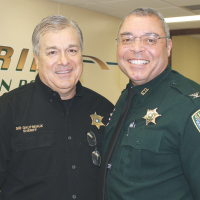
Grigsby: Merger Could Help Attack Crime
Unifying Sheriff, City Police Proposed
BATON ROUGE — Baton Rouge businessman Lane Grigsby said he wants an “honest and open dialogue and debate” on the pros and cons of merging the East Baton Rouge Sheriff’s Office and the Baton Rouge Police Department.Grigsby, who paid $100,000 for a study of what happened when law enforcement agencies were unified in Charlotte, Indianapolis, Louisville, and Las Vegas, said a merger should save taxpayers’ dollars and reduce crime.“We are not talking about small savings or an insignificant drop in the crime rate. We’re talking about significant improvements,” he said.
“Up until now, no one has really looked at how a merger would take place or what the effects would be in this parish.”
Grigsby said merging the two agencies would take amendments to the City-Parish Plan of Government and changes in state law, possibly even a constitutional amendment. He said he is moving forward aggressively and will bring proposals to the Metro Council and the Louisiana Legislature.
“The devil is in the details,” Grigsby said. “We’re not talking about reinventing the wheel. This has already been done successfully.”
Meanwhile, a group backed by Grigsby has launched an advertising campaign focused on the growing problem of violent crime in the area. The campaign, entitled “Fight, Not Fear” utilizes television, print, a web site and social media to draw public attention to the fact that crime in Baton Rouge is significantly outpacing similar-sized communities.
The ad campaign calls for unification of the Parish’s two separate police systems. A news release from www.fightnotfear.com said, “Unifying the two departments would mean greater efficiency and more police officers on the streets fighting crime.”
The Fight, Not Fear group issued the following statement:
FBI crime statistics show there has been a 40 percent increase in the Baton Rouge murder rate over the past 10 years. Baton Rouge has a higher murder rate per capita than Houston, Los Angeles, New York, Chicago, Cleveland, Boston, and Washington, D.C. The violent crime rate and the property crime rate in Baton Rouge are higher than the rates for the nation and Louisiana, according to recent FBI statistics.
Not isolated to any one neighborhood, the crime epidemic is spreading across the parish according to an article in The Advocate in March of this year. “As election day draws closer, it’s clear that the number one issue for voters in Baton Rouge is crime and the status quo is not working,” said spokesman Jay Connaughton. “City leaders are not delivering the results needed to protect the people.”
The “Fight, Not Fear” campaign highlights the problems and inefficiencies created by the current system of policing. In June, WAFB reported that Baton Rouge Police and Fire departments are short by approximately 60 officers. “The problem of crime in Baton Rouge is real and growing,” said Connaughton. “How much worse does it have to get before city leaders are willing to consider true reform? Casually nibbling around the edges will not change the dangerous trajectory the city is on.”
One reason for the growing area crime problem is that Baton Rouge has two separate police systems to service the same city. The result is double the bureaucracy and fewer officers on the streets of a city that is poised to become the crime capital of the country. Other cities across the U.S. have faced similar crime problems and cut crime by unifying their law enforcement. Charlotte, Indianapolis, Louisville, and Las Vegas have all unified their law enforcement and cut crime as a result.
Research released by the campaign shows positive outcomes from cities who chose to merge and unify their police systems. After police unification, Charlotte saw a 45 percent decrease in crime, added 200 officers and support personnel and saw an increase in police efficiency. Indianapolis witnessed a drop in murder of 20 percent and saw decreased crime rates overall, quicker response times, and a reduction in murder, property crime and vehicle theft. After unifying, Louisville had double-digit decreases in crime, sworn officers moved out of administrative positions and onto the street, and residents gave high levels of approval to police services and felt safer in their neighborhoods. Post unification, Las Vegas went from ranking number one in crime to number 205. Overall crime dropped 36 percent and violent crime dropped 52 percent. They eliminated duplication of resources and improved efficiency.
“In April of 2011, city leadership toyed with the concept of unification of law enforcement in Baton Rouge, but abandoned the concept without any study, serious consideration or opportunity for citizens to express their views on the subject.” “All the solutions to the crime problem should be on the table,” said Connaughton. “It’s time for the citizens of Baton Rouge to call on city officials to look at the facts and not be afraid to do the right thing.”
The “Fight, Not Fear” campaign calls on citizens to reach out to leadership within the community and insist that Baton Rouge unify its law enforcement and deliver results. A feature on the “Fight, Not Fear” website allows residents to lobby their community leaders asking for unification of police forces in Baton Rouge.
The “Fight, Not Fear” campaign originated with Lane Grigsby, a Baton Rouge resident and businessman, political activist and community leader. Grigsby views this campaign not as a political issue but one of protecting the future of his hometown.
To learn more about police unification, visit FightNotFear.com.


 November 1, 2012
November 1, 2012 







No comments yet... Be the first to leave a reply!